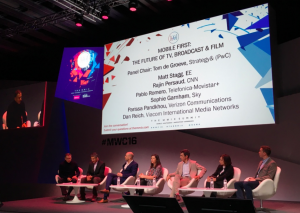
By Caesar Vallejos
Eagle News Service online correspondent
(Eagle News) — The role of mobile networks is changing the future of TV, Broadcast and Film.
This is the collective position of a distinguished set of experts from CNN, Verizon, Sky and Viacom at the track on “Mobile First: The Future of TV, Broadcast and Film” at the recently concluded Mobile World Congress in Barcelona, Spain.
The session explored the implications of mobile networks in the value chain and assessed strategies, distribution models and customer experience.
“It’s getting the CNN product in whatever platform possible,” Rajin Persaud, CNN Next Generation Business & Product Strategy said.
“For us, we look at it as expanding the pie, it is completely additive.” Persaud stressed. With CNN’s experience with Apple TV as an example, he cited that “the numbers are phenomenal. Engagement on Apple TV is three times more than the engagement on television.”
Persaud highlighted mobile’s importance by saying that “if you are actually taking the time to tune in to that and actively consume content, we think we are so much more engaged with the user.”
“The thing that we should figure out as an organization is how to efficiently and effectively distribute content across all these different platforms,” he added.
For Sophie Garnham Head of Commercial Development at Sky, mobile networks mean new markets for their content. “It allows us to reach consumers who have a different requirement and has different demands. It gives us different routes to different needs.” she exclaimed.
Also in the panel was Parissa Pandkhou, Director of product development at Verizon. The company is at the forefront of going after new technology. It is the first to launch LTE 4G and is very aggressive in the 5G space.
“If a copy of a video content is sent to a large volume of individuals, it has a heavy impact on the network. Eventually, it could denigrate your experience. It could be buffering or freezing of that video that you want to watch,” she explained.
In the mass distribution of content, whether in the form of video or data file, music or software, Pandkhou said that Verizon looks at the spectrum of possibilities of the distribution of a large content to devices or any connected device that has an LTE chipset.
Referring to the application of LTE broadcast, she said that sports in stadiums is the one that resonates immediately. “We had the Super Bowl in Sta. Clara with 80,000 people, there is only so much bandwidth that you can provide for that one game. “We want to maintain the best customer experience,” Pandkhou said.
“Younger audiences are going to mobile video,” Dan Reich announced. He is the Senior Vice President, Multiplatform Product Strategy & Development at Viacom International Media Networks.
“Nobody knows for sure what the winning business model is at this point in time so it is important for us to be in different places in whatever content, platform and type and as the business model evolves, I think we will benefit from that,” Reich justified.
What was puzzling, according to the panel is that, while there is a decrease in TV consumption of about 35 % for the past 5 years with the decrease accelerating every year in all age groups, TV advertising remains to be a stable market.
CNN’s Persaud quickly explained that if the audience is decreasing, “the audience that remained is more engaged. An audience who wants to watch is more definitive. That’s a value proposition.”







